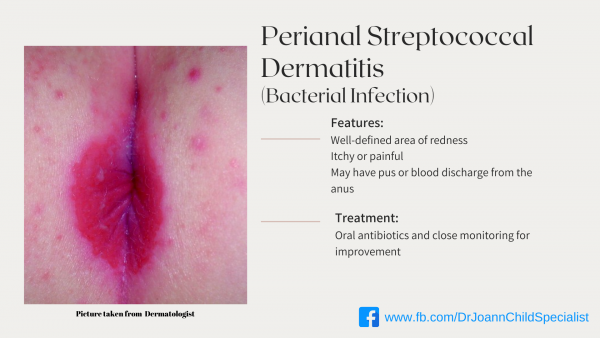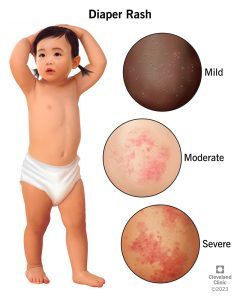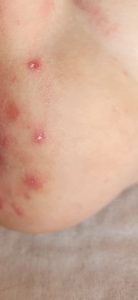Strep a diaper rash is a bacterial infection that affects the skin in the diaper area. In addition to causing a rash, it can also lead to discomfort and irritation for the baby.
This condition requires prompt treatment to prevent further complications and to provide relief for the child. Understanding the symptoms and seeking proper medical advice is essential for effective management of this infection. We will discuss the causes, symptoms, and treatment options for strep a diaper rash, as well as preventive measures parents can take to avoid its occurrence.

Understanding Strep A Diaper Rash
When it comes to your baby’s health, it’s essential to stay informed about common conditions like Strep A Diaper Rash. Understanding the causes and symptoms can help you provide the necessary care and treatment promptly. Let’s dive into the details of Strep A Diaper Rash.
Causes Of Rash
Strep A Diaper Rash is caused by Group A Streptococcus bacteria, which can thrive in warm and moist environments. Poor hygiene and prolonged exposure to wet diapers can contribute to the development of this rash. Baby’s delicate skin is more susceptible to infection, leading to irritation and inflammation.
Symptoms To Watch Out For
It’s important to recognize the symptoms of Strep A Diaper Rash to address the issue promptly. Look out for severe redness, soreness, and pimple-like bumps in the diaper area. Fever and fussiness in your baby may also indicate the presence of this rash.
Diagnosis And Identification
Diagnosing and identifying a strep diaper rash is crucial in order to provide proper treatment and prevent the condition from worsening. Medical tests for confirmation play a significant role in accurately determining whether a baby’s rash is caused by strep A bacteria or any other type of skin irritation. Additionally, differentiating a strep rash from other rashes is important to ensure appropriate care is provided. Let’s explore these aspects in detail:
Medical Tests For Confirmation
There are several medical tests that can confirm whether a diaper rash is caused by strep A bacteria or not. These tests are essential to ensure accurate diagnosis and appropriate treatment. The most common tests for confirming a diaper rash include:
- Strep Throat Culture: This test involves taking a swab of the baby’s throat to check if the strep bacterium is present. If a positive result is obtained, it helps to establish a connection between the strep infection in the throat and the diaper rash.
- Streptococcal Culture of the Diaper Area: This test involves taking a swab of the affected diaper area and analyzing it for the presence of strep A bacteria. Positive results indicate a direct correlation between the bacteria and the diaper rash.
- Blood Tests: In some cases, blood tests may be conducted to detect the presence of strep antibodies in the baby’s bloodstream. These antibodies can provide evidence of a strep infection, which may be causing or contributing to the diaper rash.
Differentiating From Other Rashes
It is important to differentiate a diaper rash from other types of rashes in order to tailor the treatment accordingly. While a rash primarily affects the diaper area, it can sometimes spread to the surrounding skin. Here are some factors that can help in distinguishing a diaper rash from other rashes:
| Characteristic | Strep Diaper Rash | Other Diaper Rashes |
|---|---|---|
| Appearance | Red and inflamed with small red spots or dots | Varies depending on the specific rash |
| Location | Primarily in the diaper area, may spread to surrounding skin | Varies depending on the rash type |
| Accompanying Symptoms | Fever, irritability, and sore throat | May or may not have accompanying symptoms |
| Response to Treatment | Improvement after appropriate antibiotic treatment | Varies depending on the rash and its cause |
Having a clear understanding of these differences can help healthcare providers to accurately identify the strep rash, leading to swift treatment and relief for the baby.
Treatment Options
When it comes to treating Strep A diaper rash, there are several options available to help alleviate the symptoms and aid in the healing process. Understanding the various treatment options can help parents and caregivers make informed decisions about managing this uncomfortable condition for their little ones.
Antibiotics Usage
For severe cases of Strep A diaper rash that are accompanied by bacterial infection, a doctor may prescribe oral antibiotics to help combat the bacterial growth and reduce inflammation. It’s crucial to complete the full course of antibiotics as prescribed by the healthcare provider to ensure the infection is fully eradicated.
Topical Treatments
Topical treatments play a vital role in managing the symptoms of Strep A diaper rash. Utilizing antibacterial creams or ointments can help in targeting the bacteria directly, while providing a protective barrier against further irritants. Zinc oxide-based creams have proven to be effective in reducing redness and promoting healing.

Prevention Methods
To prevent strep diaper rash, practicing good hygiene is crucial—frequent diaper changes, gentle cleaning with mild soap, and thorough drying. Using a barrier cream with zinc oxide can also provide protection. Avoiding irritants and ensuring proper ventilation can help prevent this uncomfortable and potentially contagious condition.
Maintaining Proper Hygiene
Regular washing of the diaper area can help prevent Strep A diaper rash.
Changing diapers frequently is crucial to reducing the risk of infection.
Using mild, fragrance-free wipes can also aid in maintaining proper hygiene.
Choosing The Right Diapers
Opt for diapers made of breathable materials to allow for air circulation.
Avoiding tight-fitting diapers can minimize friction and irritation on the skin.
Consider using diapers without harsh chemicals or dyes to prevent skin sensitivities.
Home Remedies
When your baby develops a Strep a diaper rash, it can be a discomforting experience for both the baby and the parents. However, there are several effective home remedies that can help soothe the irritation and provide relief. These natural remedies and practices not only help in alleviating the symptoms of the rash but also promote faster healing.
Natural Remedies To Soothe Irritation
If you’re looking for natural remedies to ease the discomfort caused by Strep a diaper rash, consider trying these options:
- Aloe Vera Gel: Gentle and moisturizing, aloe vera gel has soothing properties that can help reduce inflammation and itching. Apply a thin layer of pure aloe vera gel to the affected area after cleaning the rash gently.
- Coconut Oil: The antifungal and antibacterial properties of coconut oil make it an excellent natural remedy for Strep a diaper rash. Apply a thin layer of organic coconut oil to the affected area to provide a protective barrier and promote healing.
- Oatmeal Baths: Oatmeal is known for its calming and anti-inflammatory effects, making it an excellent option for relieving diaper rash irritation. Add finely ground colloidal oatmeal to lukewarm bathwater and let your baby soak in it for 10-15 minutes to soothe the skin.
Importance Of Air Exposure
Apart from using natural remedies, ensuring proper air exposure can also significantly contribute to healing a Strep a diaper rash. Allowing your baby’s bottom to breathe can help reduce moisture and promote faster recovery. Here’s how you can incorporate air exposure into your routine:
- Frequent Diaper Changes: Change your baby’s diapers frequently to keep the area clean and dry. This helps prevent moisture buildup and promotes healing.
- Naked Time: Let your baby have some diaper-free time to allow the skin to breathe. Lay a towel or waterproof mat underneath to catch any accidents.
- Loose-Fitting Diapers: Opt for loose-fitting diapers to promote airflow and reduce friction. Avoid using plastic pants or tight diapers that can trap moisture.
By following these simple home remedies and incorporating air exposure into your baby’s routine, you can effectively alleviate the symptoms of Strep a diaper rash and ensure your baby’s comfort. Remember, if the rash persists or worsens, it’s always recommended to consult a healthcare professional for further guidance and treatment.
When To Consult A Doctor
If your baby has a Strep a Diaper Rash, it’s crucial to know when to seek medical advice.
Symptoms Of Complications
- Bleeding or oozing sores
- Fever over 100.4°F
- Severe pain or discomfort
Understanding Recurrence Risk
- Monitor rash closely for any changes
- Consult pediatrician if rash persists or worsens
- Follow doctor’s recommendations for treatment

Can Strep Cause A Diaper Rash?
Yes, strep can cause rash due to the bacteria’s ability to spread through skin contact. It’s essential to seek medical attention for proper diagnosis and treatment. Regular diaper changes and maintaining good hygiene can help prevent diaper rash caused by strep.
How Do You Treat Perianal Strep?
Perianal strep is treated with antibiotics prescribed by a doctor to kill the bacteria causing the infection. Keeping the affected area clean and dry can also help prevent the infection from spreading.
What Does Strep A Look Like In Babies?
Strep A in babies can present as red throat with white patches, fever, swollen lymph nodes. Rash, difficulty swallowing.
What Are The Symptoms Of Invasive Strep A In Babies?
Symptoms of invasive strep A in babies include fever, irritability, rash, difficulty breathing, and lethargy. Prompt medical attention is crucial.
Conclusion
Understanding the possibility of Strep A causing diaper rash is crucial for parents and caregivers. By recognizing the symptoms and seeking prompt medical attention, the infection can be treated effectively. Maintaining good hygiene practices and regularly changing diapers can also help prevent the spread of the bacteria.
By staying informed and proactive, we can provide the best care for our little ones and ensure their health and well-being.





